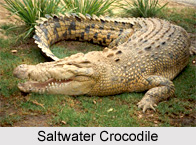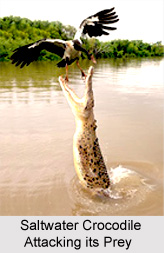 Saltwater Crocodile is the largest of all living reptiles, as well as the largest terrestrial and riparian predator in the world. Also called estuarine or Indo-Pacific crocodile, it is referred to as the saltie, marine or sea-going crocodile. It usually lives in mangrove swamps, estuaries, deltas, lagoons, and lower stretches of rivers. Saltwater crocodiles are considered a danger to human beings as they have a strong tendency to treat humans in their territory as prey.
Saltwater Crocodile is the largest of all living reptiles, as well as the largest terrestrial and riparian predator in the world. Also called estuarine or Indo-Pacific crocodile, it is referred to as the saltie, marine or sea-going crocodile. It usually lives in mangrove swamps, estuaries, deltas, lagoons, and lower stretches of rivers. Saltwater crocodiles are considered a danger to human beings as they have a strong tendency to treat humans in their territory as prey.
Physical Features of Saltwater Crocodile
The newly hatched Saltwater Crocodiles measure about 25 to 30 cm long and weigh an average of 70 g. By their second year, they grow up to 1 m long and weigh around 2.5 kg. An adult male saltwater crocodile is normally 3.5 to 5.2 m long, weighing 200 to 1,000 kg. The head is very large and the teeth are long. The young crocodiles are pale yellow in colour with black stripes and spots on their bodies and tails. They remain in this colour until they mature into adults. The mature crocodiles are much darker greenish-drab in colour with a few lighter tan or grey areas sometimes apparent. Their tails are grey with dark bands. The male saltwater crocodiles reach sexual maturity around 3.3 m at around 16 years of age, while females reach sexual maturity at 2.1 m and 12-14 years of age.
Habitat of Saltwater Crocodile
The saltwater crocodile is one of the three crocodilians found in India, the other two being the smaller mugger crocodile and the narrow-snouted gharial. Apart from the eastern coast of India, they are extremely rare on the Indian subcontinent. A huge population, consisting of many large adults, is present within the Bhitarkanika Wildlife Sanctuary of Odisha. They are also known to be present in smaller numbers throughout the Indian and Bangladeshi portions of the Sundarbans. It is also reported that they are present within the mangrove forests and other coastal areas of the Andaman and Nicobar Islands in India.
 The saltwater crocodiles prefer to spend the tropical wet season in freshwater swamps and rivers and the dry season in estuaries. They fiercely fight with each other for territory and usually the dominant males occupy the most eligible stretches of freshwater creeks and streams, forcing the young crocodiles into the more marginal river systems and sometimes into the ocean. They can travel long distances at sea and like all crocodiles, they can survive for prolonged periods only in warm temperatures.
The saltwater crocodiles prefer to spend the tropical wet season in freshwater swamps and rivers and the dry season in estuaries. They fiercely fight with each other for territory and usually the dominant males occupy the most eligible stretches of freshwater creeks and streams, forcing the young crocodiles into the more marginal river systems and sometimes into the ocean. They can travel long distances at sea and like all crocodiles, they can survive for prolonged periods only in warm temperatures.
Behavioural Pattern of Saltwater Crocodile
As the name hints, these crocodiles have a tendency to occupy salt water. They use ocean currents to travel long distances. The current-riding behaviour allows them for the conservation of energy. Sometimes, they interrupt their travels by residing in sheltered bays for a few days, when the current is against the desired direction of travel, until the current changes direction. They also periodically travel up and down in river systems.
Unlike most crocodilians, saltwater crocodiles are usually territorial and are less tolerant of their own kind. The adult males share territory with females, but do not let rivals males to hover around in their area. They mate in the wet season. The females lay eggs in a nest consisting of a mound of mud and vegetation and also guard the nest and hatchlings from predators.
Saltwater crocodiles are generally very lethargic and can survive months at a time without food. However, they are among the most active of all crocodilians. Another feature of this reptile is that it is capable of learning difficult tasks with very little conditioning.
Diet of Saltwater Crocodile
The young saltwater crocodiles eat smaller animals such as small fish, frogs, insects, small aquatic invertebrates, variety of freshwater and saltwater fish, various amphibians, birds and small to medium-sized mammals. The adult saltwater crocodiles eat larger animals like deer, wild boar, Malayan tapirs, kangaroos, orangutans, dholes, pythons, monitor lizards, Asian antelopes such as serow and nilgai and large bovines such as banteng, water buffalo and gaur. Given an opportunity, they can also eat any type of domestic livestock, such as chicken, sheep, pigs, horses, cattle etc. The saltwater crocodile is an extremely powerful animal, being able to attack and overpower animals of at least equal to their own size.



















